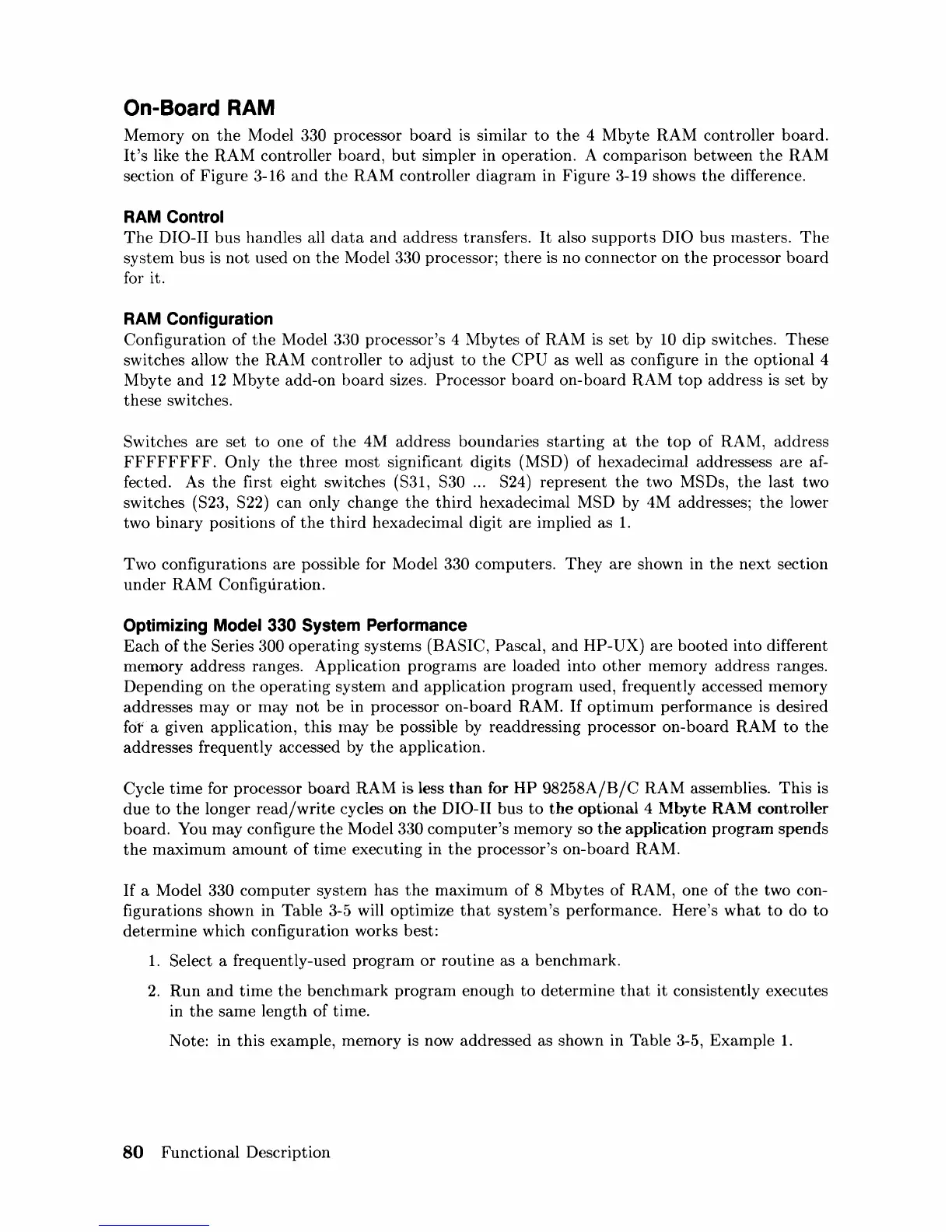On-Board RAM
Memory
on
the
Model 330 processor
board
is similar
to
the
4
Mbyte
RAM
controller
board.
It's
like
the
RAM
controller
board,
but
simpler in operation. A comparison between
the
RAM
section
of
Figure
3-16
and
the
RAM
controller
diagram
in Figure 3-19 shows
the
difference.
RAM Control
The
DIO-II
bus
handles all
data
and
address transfers.
It
also
supports
DIO
bus
masters.
The
system
bus
is
not
used on
the
Model 330 processor;
there
is no connector
on
the
processor
board
for it.
RAM Configuration
Configuration
of
the
Model 330 processor's 4 Mbytes
of
RAM is set by
10
dip switches. These
switches allow
the
RAM
controller
to
adjust
to
the
CPU
as well as configure in
the
optional 4
Mbyte
and
12
Mbyte
add-on
board
sizes. Processor
board
on-board
RAM
top
address is set by
these
switches.
Switches are set
to
one
of
the
4M address boundaries
starting
at
the
top
of
RAM, address
FFFFFFFF.
Only
the
three
most significant digits (MSD)
of
hexadecimal addressess are af-
fected. As
the
first eight switches (S31, S30 ... S24) represent
the
two MSDs,
the
last two
switches
(S23, S22)
can
only change
the
third
hexadecimal MSD by 4M addresses;
the
lower
two
binary
positions
of
the
third
hexadecimal digit are implied as
1.
Two
configurations are possible for Model 330 computers.
They
are shown in
the
next
section
under
RAM
Configuration.
Optimizing Model 330 System Performance
Each
of
the
Series 300
operating
systems (BASIC, Pascal,
and
HP-UX) are
booted
into different
memory address ranges. Application
programs
are loaded into
other
memory address ranges.
Depending
on
the
operating
system
and
application
program
used, frequently accessed memory
addresses
mayor
may
not
be
in processor
on-board
RAM.
If
optimum
performance is desired
fot a given application,
this
Inay
be
possible by readdressing processor
on-board
RAM
to
the
addresses frequently accessed by
the
application.
Cycle
time
for processor
board
RAM
is less
than
for
HP
98258A/B/C
RAM assemblies.
This
is
due
to
the
longer
read/write
cycles
on
the
DIO-II
bus
to
the
optional
4
Mbyte
RAM controller
board.
You
may
configure
the
Model 330
computer's
memory so
the
application
program
spends
the
maximum
amount
of
time
executing in
the
processor's
on-board
RAM.
If
a Model 330
computer
system has
the
maximum
of 8
Mbytes
of
RAM, one
of
the
two con-
figurations shown in Table 3-5 will optimize
that
system's
performance. Here's
what
to
do
to
determine
which configuration works best:
1.
Select a frequently-used
program
or
routine
as a benchmark.
2.
Run
and
time
the
benchmark
program
enough
to
determine
that
it
consistently executes
in
the
same
length
of
time.
Note: in
this
example, memory
is
now addressed as shown in Table 3-5,
Example
1.
80
Functional Description

